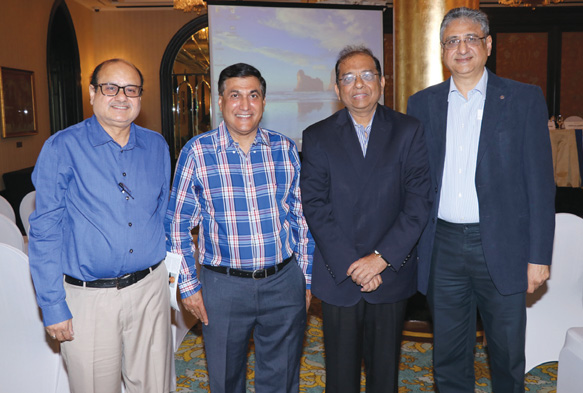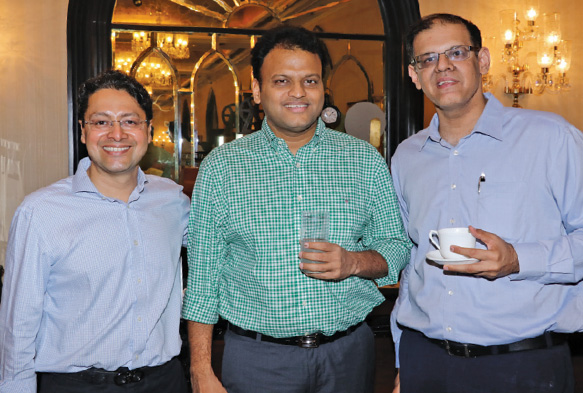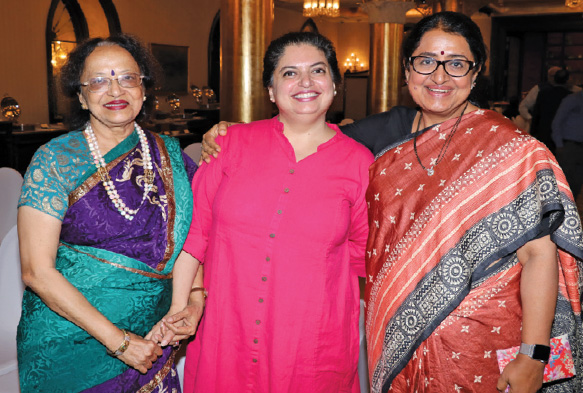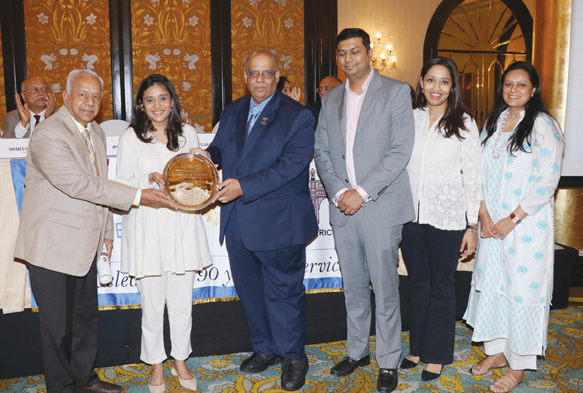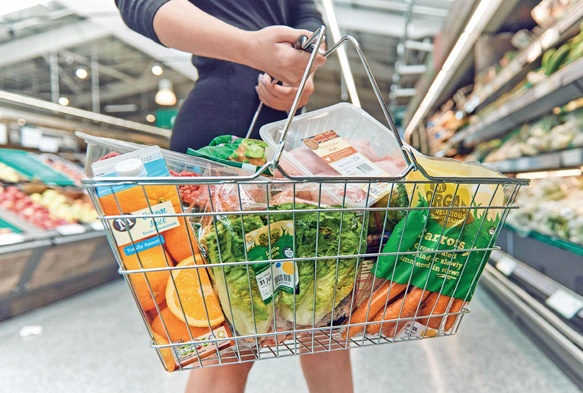
THE GREAT INDIAN FOOD HAUL
The Indian economy is poised to hit $5 trillion in the next five years, with estimated food consumption at $1 trillion by 2025. The future of the food business in India is likely to be shaped by the following factors:
FOOD PREFERENCES HAVE CREATED NEW, MICRO COMMUNITIES
~ People are travelling more than before. Migration has enabled cuisines from different parts of the world to become integral to the global, urban fabric. ~ Increased exposure has given birth to the “Foodie”.
~ Social media infiltration has enabled us to vicariously experience cuisines and cultures through other people’s profiles and feeds.
~ Further, people are identifying their personalities with their diets. Be it keto, veganism or intermittent fasting, our social interactions are now largely impacted by what and how we eat.
These communities bring together like-minded individuals and create a market for highly specific products.

LAST TUESDAY’S SPEAKER
Concept head of Foodhall,
Avni Biyani talked about the future of the food business in India. Avni was presented with the Uma Jain Young Achievers Award for the year 2018-19.
~ With the emergence of millennials as a highspending, fairly discerning market, there has been a surge in innovation and diversification of products.
~ We might not want to consume brands and products that the older generations did.
~ The coolness quotient associated with certain brands is a strong business driver. Small batches, boutique, artisanal, and handmade are descriptors commonly associated with this movement.
DISRUPTION IS THE BUZZWORD THESE DAYS
Disruption has prompted multinational companies and legacy brands to acquire start-ups or launch innovation labs. These disruptive brands log into megatrends and are agile and responsive to consumers’ changing needs.
~ Millennials identify with these brands.
~ ‘Healthy living and wellness’ is a mantra that most millennials swear by.
~ Sugar has come under the radar.
Beverage and snacking companies that have a sugar percentage of more than 25 per cent are being asked to come up with
healthy alternatives. Social media has led this activist-like movement along with nutritionists, doctors and government. This is forcing companies to re-evaluate their product portfolio and strategies.
GUT HEALTH, LINKED TO MENTAL HEALTH AND PERFORMANCE, IS AN UPCOMING TREND
Fermentation and pickling are becoming more ubiquitous, with pro-biotic claims featuring across a wide range of food products. We now have several brands of kefir, kombucha, fermented pickles and sauerkraut – products unheard of just three years ago. As we delve deeper into this phenomenon, ancient food and cooking methods are coming back.
THE FUTURE MAY VERY WELL BE IN THE PAST
Ancient tenets of eating are proving their relevance in modern living. There is an ongoing Renaissance of traditional eating habits consuming local and seasonal produce, millets and ancient grain.
FOCUS WILL SHIFT FROM WEIGHT MANAGEMENT TO NUTRITION AND WELLBEING
The industry has seen a rise in uncooked / unprocessed foods that have not been heated above 48°C, preserving most of
their natural vitamins and minerals.
~ Ayurveda is being relied upon heavily, especially in the context of viewing food as a medicine to restore balance. Turmeric, A2 cow ghee and other foods with Ayurvedic significance are experiencing a resurgence in popularity for their healing or curative properties.
~ Ayurveda helps cure diseases and promotes a healthy lifestyle. It is a proactive way of life as opposed to a reactive treatment and I believe more brands and companies will take advantage of Indian heritage and revive Ayurveda and its philosophy.
SUSTAINABILITY AND TRANSPARENCY IN THE VALUE CHAIN
~ With the introduction of new materials and substrates in packaging, there is a demand for businesses to meet
ethical benchmarks.
~ Customers are actively seeking and choosing conscious brands as these fulfill an emotional responsibility towards the world around us. Government along with active civic citizen groups and bodies are shaping the discourse on reducing wastage, and the consumption of plastic and other harmful materials.
~ Companies will have to evaluate their carbon footprint during the manufacturing process and pass the litmus test when it comes to packaging.
FOOD IS ‘CONTENT’ AND DIGITAL MEDIA IS CHANGING HOW WE INTERACT WITH IT
The act of producing and consuming food is being looked at as an experience worth documenting. What was once a chore is now considered content – food has become theatrical.
Supermarkets are building experiences that bring the consumer back to the brick-and-mortar establishment in order to make the visit worth it. Consumer emphasis is shifting from possession to experience. In order to keep up with the market’s thirst for experiences, we need to design them, drive engagement and build curiosity.
NOVEL EXPERIENCES ARE TRENDY
While the e-commerce and digital worlds offer consumer convenience and accessibility, there is no replacement for a physical experience and the resulting memory of having seen something novel.
Be it immersive dining, master-classes, events or installations, experiences are being increasingly employed to gain customer interest and engagement. Indulgence is and always will be a core driver in foods. However, it is changing
shape and form as consumers crave different products and experiences for different occasions and in different geographies. I recently visited the museum of ice-cream in San Francisco which took me on a journey of ice-cream down the ages and engaged my senses.
In the new world we now live in, personalisation of a customer’s shopping journey through data and artificial intelligence is critical. The more we know about our customers, the better we conserve them. Data is imperative to the growth and evolution of a business — strategies like predictive purchasing, targeted marketing can only be put in
place on the basis of collection and analysis of customer data.
The future will be determined by how will we can implement data-driven value chain. Technology is becoming more important in the distribution and delivery of food. This is manifesting itself in the increased application of block-chain to monitor traceability and direct selling to challenge the bargaining power of retailers, and nutrition apps that provide tailored nutrition plans for health-conscious consumers.
CONVENIENCE IS KING
Households are shrinking. This has led to a new consumer class that does not wish to sacrifice taste and nutrition and yet needs affordable and convenient options. This has led to a rise in food delivery apps. Minimal effort and investment by customers can still lead to a satisfying meal in the comfort of one’s own home. The uptick in the ordering-in phenomenon has dislodged the home kitchen from its pre-eminent status; conversely, there are strong digital platforms that depict cooking in simple and achievable terms. The future of food will be shaped by these opposing forces of convenience versus effort and how we manoeuvre this tightrope.
The rising popularity of delivery kitchens has resulted in the creation of satellite kitchens from where food can be prepared and dispensed. The relatively low overhead has led to unique concepts like subscription models for dietcompliant meals, bespoke services and online-offline hybrids.
Thus, as we increasingly rely on technology and the digital age to drive over-reaching business objectives, there must continue to be an equal focus on the anthropology of food. Ultimately, the study of the Indian market lies in culture and our culture is best understood through food.
Rotarians ask
Why is Indian food considered downmarket compared imported foods?
I would like to counter this. The world and its discourse has changed in the last five years. Back in the day, when Indians migrated abroad, ghettos were created and Indian food was available only in ghettos. Now, if you see food blogs such as Manjula’s Kitchen or Hebbar’s Kitchen, you can see the ways in which Indian food is being romanticised.
How do you deal with expiry dates of exotic foods? You must have a large stock.
Dump levels and shrinkage levels in Foodhall are actually very low. It is about 5.5 per cent which is not very high because it also includes water loss and other shrinkages. We keep designing innovative offers and talking to customers and use data to ensure that we don’t end up having a large issue with expired products.
Does Foodhall stock vegan products?
Yes, one of our most selling products is the coconut yoghurt which is pure vegan. We make it in our kitchens. Our cookery studio in Bandra hosts vegan cheesemaking workshops. We also have decent number of vegan cheeses in-store. Veganism is catching on as a trend and we believe in offering everything our customer wants.
What is the sustainability aspect of your business?
Sustainability for me means doing anything and everything that will not interfere or misalign nature in any way. For example, we want to start wrapping all food products in banana leaves, if possible. We believe that we can do something like this and, at the same time, the costs does not go out to the consumer. We recycle as much as we can, the packaging that we produce or create has a recycle angle to it. We encourage consumers to bring their own cloth bags from homes and charge for paper bags; not using plastic does not mean paper bags are sustainable.

